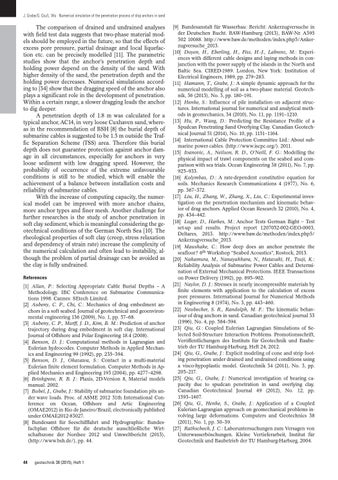J. Grabe/G. Qiu/L. Wu · Numerical simulation of the penetration process of ship anchors in sand
The comparison of drained and undrained analyses with field test data suggests that two-phase material models should be employed in the future, so that the effects of excess pore pressure, partial drainage and local liquefaction etc. can be precisely modelled [11]. The parametric studies show that the anchor’s penetration depth and holding power depend on the density of the sand. With higher density of the sand, the penetration depth and the holding power decreases. Numerical simulations according to [34] show that the dragging speed of the anchor also plays a significant role in the development of penetration. Within a certain range, a slower dragging leads the anchor to dig deeper. A penetration depth of 1.8 m was calculated for a typical anchor, AC14, in very loose Cuxhaven sand, whereas in the recommendation of BSH [8] the burial depth of submarine cables is suggested to be 1.5 m outside the Traffic Separation Scheme (TSS) area. Therefore this burial depth does not guarantee protection against anchor damage in all circumstances, especially for anchors in very loose sediment with low dragging speed. However, the probability of occurrence of the extreme unfavourable conditions is still to be studied, which will enable the achievement of a balance between installation costs and reliability of submarine cables. With the increase of computing capacity, the numerical model can be improved with more anchor chains, more anchor types and finer mesh. Another challenge for further researches is the study of anchor penetration in soft clay sediment, which is meaningful considering the geotechnical conditions of the German North Sea [10]. The rheological properties of soft clay (creep, stress relaxation and dependency of strain rate) increase the complexity of the numerical calculation and often lead to instability, although the problem of partial drainage can be avoided as the clay is fully undrained. References [1] Allan, P.: Selecting Appropriate Cable Burial Depths – A Methodology. IBC Conference on Submarine Communications 1998. Cannes: SEtech Limited. [2] Aubeny, C. P., Chi, C.: Mechanics of drag embedment anchors in a soft seabed. Journal of geotechnical and geoenvironmental engineering 136 (2009), No. 1, pp. 57–68. [3] Aubeny, C. P., Murff, J. D., Kim, B. M.: Prediction of anchor trajectory during drag embedment in soft clay. International Journal of Offshore and Polar Engineering 18.4 (2008). [4] Benson, D. J.: Computational methods in Lagrangian and Eulerian hydrocodes. Computer Methods in Applied Mechanics and Engineering 99 (1992), pp. 235–394. [5] Benson, D. J., Okazawa, S.: Contact in a multi-material Eulerian finite element formulation. Computer Methods in Applied Mechanics and Engineering 193 (2004), pp. 4277–4298. [6] Brinkgreve, R. B. J.: Plaxis, 2D-Version 8, Material models manual. 2002. [7] Bubel, J., Grabe, J.: Stability of submarine foundation pits under wave loads. Proc. of ASME 2012 31th International Conference on Ocean, Offshore and Artic Engineering (OMAE2012) in Rio de Janeiro/Brazil, electronically published under OMAE2012-83027. [8] Bundesamt für Seeschifffahrt und Hydrographie: Bundesfachplan Offshore für die deutsche ausschließliche Wirtschaftszone der Nordsee 2012 und Umweltbericht (2013), (http://www.bsh.de/), pp. 44.
44
geotechnik 38 (2015), Heft 1
[9] Bundesanstalt für Wasserbau: Bericht: Ankerzugversuche in der Deutschen Bucht. BAW-Hamburg (2013), BAW-Nr. A395 502 10088. http://www.baw.de/methoden/index.php5/Ankerzugversuche_2013. [10] Doyen, H., Eberling, H., Fiss, H.-J., Labrenz, M.: Experiences with different cable designs and laying methods in conjunction with the power supply of the islands in the North and Baltic Sea. CIRED-1989. London, New York: Institution of Electrical Engineers, 1989, pp. 279–283. [11] Hamann, T., Grabe, J.: A simple dynamic approach for the numerical modelling of soil as a two-phase material. Geotechnik, 36 (2013), No. 3, pp. 180–191. [12] Henke, S.: Influence of pile installation on adjacent structures. International journal for numerical and analytical methods in geomechanics, 34 (2010), No. 11, pp. 1191–1210. [13] Hu, P., Wang, D.: Predicting the Resistance Profile of a Spudcan Penetrating Sand Overlying Clay. Canadian Geotechnical Journal 51 (2014), No. 10, pp. 1151–1164. [14] International Cable Protection Committee Ltd.: About submarine power cables. (http://www.iscpc.org/). 2011. [15] Ivanovic, A., Neilson, R. D., O’Neill, F. G.: Modelling the physical impact of trawl components on the seabed and comparison with sea trials. Ocean Engineering 38 (2011), No. 7, pp. 925–933. [16] Kolymbas, D.: A rate-dependent constitutive equation for soils. Mechanics Research Communications 4 (1977), No. 6, pp. 367–372. [17] Liu, H., Zhang, W., Zhang, X., Liu, C.: Experimental investigation on the penetration mechanism and kinematic behavior of drag anchors. Applied Ocean Research 32 (2010), No. 4, pp. 434–442. [18] Luger, D., Harkes, M.: Anchor Tests German Bight – Test set-up and results. Project report 1207052-002-GEO-0003, Deltares, 2013. http://www.baw.de/methoden/index.php5/ Ankerzugversuche_2013. [19] Maushake, C.: How deep does an anchor penetrate the seafloor? 6th Workshop “Seabed Acoustics”, Rostock, 2013. [20] Nakamura, M., Nanayakkara, N., Hatazaki, H., Tsuji, K.: Reliability Analysis of Submarine Power Cables and Determination of External Mechanical Protections. IEEE Transactions on Power Delivery (1992), pp. 895–902. [21] Naylor, D. J.: Stresses in nearly incompressible materials by finite elements with application to the calculation of excess pore pressures. International Journal for Numerical Methods in Engineering 8 (1974), No. 3, pp. 443–460. [22] Neubecker, S. R., Randolph, M. F.: The kinematic behaviour of drag anchors in sand. Canadian geotechnical journal 33 (1996), No. 4, pp. 584–594. [23] Qiu, G.: Coupled Eulerian Lagrangian Simulations of Selected Soil-Structure Interaction Problems. Promotionsschrift, Veröffentlichungen des Instituts für Geotechnik und Baubetrieb der TU Hamburg-Harburg, Heft 24, 2012. [24] Qiu, G., Grabe, J.: Explicit modeling of cone and strip footing penetration under drained and undrained conditions using a visco-hypoplastic model. Geotechnik 34 (2011), No. 3, pp. 205–217. [25] Qiu, G., Grabe, J.: Numerical investigation of bearing capacity due to spudcan penetration in sand overlying clay. Canadian Geotechnical Journal 49 (2012), No. 12, pp. 1393–1407. [26] Qiu, G., Henke, S., Grabe, J.: Application of a Coupled Eulerian-Lagrangian approach on geomechanical problems involving large deformations. Computers and Geotechnics 38 (2011), No. 1, pp. 30–39. [27] Rathscheck, J. C.: Laboruntersuchungen zum Versagen von Unterwasserböschungen. Kleine Vertieferarbeit, Institut für Geotechnik und Baubetrieb der TU Hamburg-Harburg, 2004.
